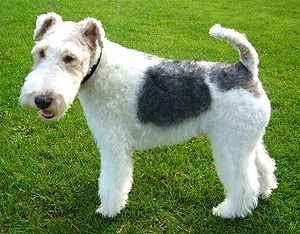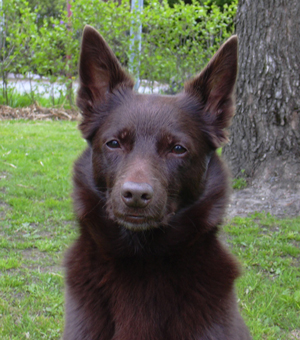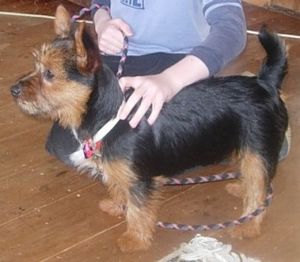 |
| Vital Statistics: |
| Place of Origin: England |
| Group: Terrier |
| Height: males 14-16 in., females 13-15 in. |
| Weight: males 15-20 lbs., females 13-18 lbs. |
| Life span: 15 yrs. or more |
| Trainability: high |
| Good with children: yes, with respectful children |
| Good with other pets: yes with dogs, sometimes chase small animals |
What are the origins of the Smooth & Wire-haired Fox Terrier?
Terrier type dogs have been known in Britain since 55 B.C. First reports of true terriers were described by Dr. John Caius in 1570. The terriers of today were bred by crossing ancient Dachshunds, the English Hound, Foxhound and the Beagle.
What do the Smooth and Wire-haired Fox Terriers look like?
Both types are about 13-16 inches tall and weigh about 13-20 lbs. The skull is flat with a muzzle that narrows to a black nose. Eyes are small and dark. Ears are v-shaped and fold forward. The tail is carried high, sometimes docked to 1/4 its length. The Smooth Terrier as the name implies has an abundant, smooth coat while the Wire-hair’s coat is dense, wiry and stiff, sometimes wavy. The undercoat is soft and fine. The Wire-hairs coat needs professional grooming. Colors for both are white with patches of black or brown.
What is the temperament of the Smooth & Wire-haired Fox Terrier?
The temperament is the same for both types. They are independent thinkers and need lots of physical and mental stimulation. They are very devoted and affectionate with the family, but reserved with strangers. When out walking with the Terriers, they should be leashed. If you have a backyard, it should be fenced in. They sometimes chase cats and small animals.They are good with children who treat them gently. They are very intelligent and sensitive to mood changes in their owners. Terriers are very lively and active and need lots of exercise and long walks.
What are the uses of the Smooth & Wire-haired Fox Terrier?
They were bred as hunting dogs as they were able to follow small animals and foxes into their dens and face them down. Today they are often used as therapy dogs and love to compete. Most of all these Terriers are loving, protective companion dogs.
Possible Health Issues
Atophy (skin sensitivies, itching), myesthenia gravis (neurological problem), cataracts, glaucoma, pulmonic stenosis, Wolman disease (lipid storage problem)
Smooth Fox Terrier – patellar luxation, ataxia, myelopathy (general weakness and muscle degeneration)
Wire-haired Fox Terrier – hemophilia B, epilepsy
- Airedale Terrier
- American Pit Bull Terrier
- American Stratfordshire Terrier
- Australian Terrier
- Bedlington Terrier
- Black Russian Terrier
- Border Terrier
- Boston Terrier
- Bull Terrier
- Cairn Terrier
- Cesky Terrier
- Dandie Dinmont Terrier
- English Toy Terrier
- Glen of Imaal Terrier
- Irish Terrier
- Jack Russell Terrier
- Lakeland Terrier
- Manchester Terrier
- Miniature Schnauzer
- Moscow Toy Terrier
- Norfolk Terrier and Norwich Terrier
- Old English Terrier
- Scottish Terrier
- Silky Terrier
- Skye Terrier
- Soft-coated Wheaten Terrier
- Tibetan Terrier
- Toy Fox Terrier
- Welsh Terrier
- West Highland White Terrier
- Wire Fox Terrier
- Yorkshire Terrier
- Airedale Terrier
- Beagle
- Bedlington Terrier
- Bluetick Coonhound
- Border Collie
- Border Terrier
- Bull Terrier
- Bulldog
- Bullmastiff
- Ca de Bou
- Cavalier King Charles Spaniel
- Clumber Spaniel
- Collie
- Curly-coated Retriever
- Dandie Dinmont Terrier
- English Cocker Spaniel
- English Foxhound
- English Setter
- English Springer Spaniel
- English Toy Terrier
- Flat-coated Retriever
- Golden Retriever
- Greyhound
- Harrier
- Jack Russell Terrier
- Lakeland Terrier
- Lancashire Heeler
- Llewellyn Setter
- Manchester Terrier
- Mastiff
- Norfolk Terrier and Norwich Terrier
- Old English Sheepdog
- Old English Terrier
- Otterhound
- Parson Russell Terrier
- Shetland Sheepdog
- Sussex Spaniel
- Welsh Terrier
- Whippet
- Wire Fox Terrier
- Yorkshire Terrier



